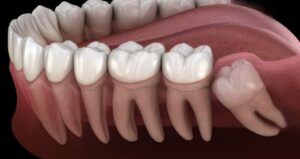What are Wisdom Teeth?
Wisdom tooth infection symptoms – Wisdom teeth are the third and the last molars that erupt in the mouth in the adolescent age or later in life.

As their eruption occurs after the complete development of a mouth, often there is little or no space left in a jaw for them to emerge into the oral cavity. Therefore, they frequently erupt at angles, or completely sideways. They sometimes force themselves into the jawbone because of no or little space in the arch itself, because of which they either erupt partially into the arch or stay impacted (below the gum line). The abnormal shape and eruption problems related to the wisdom tooth are responsible for causing various complications.
How Wisdom Teeth get Infected?
Wisdom tooth infection because of the following reasons:
1) Firstly, difficulty in cleaning because of their position in the mouth. Early stage wisdom tooth infection, without proper cleaning, bacteria gets easy access to the area surrounding the teeth. Brushing and flossing the in-between and the posterior area of the wisdom teeth is often missed. This becomes the reason for the occurrence of the infection.
2)Secondly, the wisdom tooth mostly erupts partially into the oral cavity because of minimal space available in the arch, or sometimes at an angle to the normal expected development, and sometimes completely sideways. Because of this irregularity in shape and their angle, there is a higher risk of infection and decay. Bacteria gain easy access to such teeth which further leads to the formation of a cavity, causing infection.

The infection surrounding the impacted or partially erupted wisdom teeth is commonly known as “pericoronitis”. Pericoronitis is the inflammation of the soft tissues that surround the partially erupted teeth which include the gingiva and the dental follicle. Symptoms for pericoronitis include severe pain around the teeth, swelling of the gum tissue, and further, if not kept clean and left untreated may lead to pus discharge and trismus (lockjaw). Also, in the long term, it may become the reason for bad breath and a bad taste in the mouth.
A very rare but possible life-threatening complication of the untreated pericoronitis is Ludwig’s angina and sepsis where the infection spreads into the head and neck, or the bloodstream.
Common Infected Wisdom Tooth Symptoms:
-
Pain in or around the tooth: Swelling and prevailing infection surrounding the tooth results in severe pain.
- Pain in the jaw or the side of the face: Infected wisdom tooth symptoms, when the infection is left untreated, there is a problem in chewing and opening of the mouth. Also, when there is not enough room for the eruption of the teeth in a jaw, the teeth finds its way out from the jaw bone, which results in the lockjaw or severe pain on that side of the mouth.
- Swelling or redness of the gums around the tooth: inflammation occurs because of the infection.
- Bad breath: improper care and poor hygiene results in the accumulation of the food particles in the pocket formed between the erupting and the adjacent tooth. This food accumulation is the cause of bad breath.
- Difficulty in chewing: Pain and difficulty in opening the mouth because of the infection ultimately affect the chewing.
.
- Difficulty opening the mouth.
- Swollen lymph glands: When an infection is left untreated, the long term existing infection results in the swelling of the lymph nodes.
-
Fever: Infection shows up as fever.
Treatment:
Medications like pain relievers and antibiotics are suggested for the pain and the infection.
Visiting your dentist should be the first step. The dentist will examine the teeth, take the needed X-ray, and will determine the best possible treatment for the problem.
Some possible treatment modalities are as follows:
1) After the infection subsides with the help of the prescribed medications, the dentist will fix or repair the tooth. If the caries is the reason for infection, the cavity will be properly cleaned and restored.
2) Improper shape or abruptly erupted teeth can be smoothened so that no rough or bumpy edges remain. This may deter the food particles and the bacteria from being trapped into the gum tissue.
3)Extraction: Wisdom tooth is considered a vestigial part of the body. It serves no purpose in the oral cavity. Therefore, if it is creating problems in eruption, the most dentist will suggest its removal. Dental surgery may be needed for this disimpaction procedure. This will help in preventing future infections.
4) Sometimes only the extra gum tissue covering the erupting crown is removed, this gradually helps in the complete eruption of the teeth. This is possible if the only hurdle in eruption is the extra gum tissue.
5) Sometimes a procedure known as coronectomy is done, where only the top part of the wisdom tooth is removed. This helps in the protection of the roots, nerves, and the jaw bone surrounding the tooth.
In most cases, the removal of the tooth or its parts usually rectifies the issue. However, sometimes it is beneficial to retain the tooth, such as when other molars are missing in the oral cavity, the saved wisdom tooth can take their place and can serve on their behalf.
Therefore, the proper treatment modality is completely dependent on the analysis done by a dentist. As every case is different, only a dentist can suggest the best possible treatment for a particular case.
Home remedies:
Home remedies can be used as an adjuvant to the treatment. It helps in pain-relief and eases the discomfort both before and after the treatment is done.
- The main home remedy is to keep the area clean. Warm-saline gargles are the best when the infection is still there. Keeping the area clean will help to get rid of the infection as soon as possible. Moreover, it will save the situation from going on the worse side. Regular and proper brushing and flossing are advised.
- Cold compress on the affected side can soothe the swelling and inflammation.
- Diluted hydrogen peroxide can be used as a mouthwash, being antibacterial it will help in removing some of the surface bacteria around the infection.
- Clove oil also contains antibacterial properties. Putting a cotton swab on the affected wisdom tooth will help in easing the swelling and pain.
Signs of Wisdom Tooth Infection
Caution: Strictly avoid hot compress. If fever persists, seek medical attention as soon as possible.
There is a misbelief that the appearance of a wisdom tooth in a mouth makes a person smarter. They are known as “ Wisdom teeth” because they appear in the late teens or even later, suggesting maturity with being older. Therefore, if they create problems in erupting, or if there are signs of recurrent infections, do not fear of losing your wisdom and make an appointment with your dentist in the first place.
